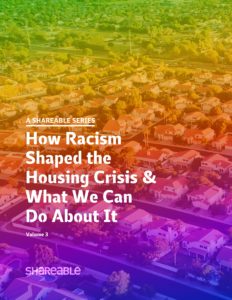While the single family house is central to the American Dream, this dream didn’t emerge organically from the desires of ordinary Americans. It was aggressively promoted, regulated, and financed into existence through a hodgepodge of local, state, and federal government efforts starting over 100 years ago. As a result, the single family house became America’s dominant housing type and aspired to ideal. Yet, this manufactured dream and its complicated evolution masks a deeply racist history.
The dream was built on the foundation of exclusionary zoning, which specifies one house and family per lot. Exclusionary zoning and more were used to exclude African Americans from white neighborhoods and relegate them to relatively small, crowded, and chronically underinvested areas in cities across the US. This shadow apartheid not only contributed significantly to huge wealth and other disparities between black and white Americans, it also laid the foundation for the housing crisis we face today in San Francisco and other job-rich metros.
Around 75% of urban land in the Bay Area is zoned single family according to SPUR. This is typical of American cities. This extremely wasteful use of land has played a central role in making housing unnecessarily expensive and scarce, not to mention contributing to wealth inequality, segregation, climate change, social isolation, and more.
However, the day of reckoning may have arrived. Many cities and states face such severe housing shortages that this bulwark of the American dream is being reconsidered. Minneapolis banned single family zoning citywide last year, a historic first. Oregon, California, several major cities, and even some presidential candidates are looking at residential zoning reform. It’s a miracle that this trend is going nationwide in a land where NIMBYism has ruled, but we’re unprepared to take advantage of this rare opportunity for change.
Public discourse rarely reflects the racist history of US housing or knowledge of more successful housing paradigms elsewhere. If we don’t enrich our discourse, we could make inequality, segregation, and affordability worse. We could also miss the opportunity to address past systemic injustices and other urgent challenges inextricably tied to housing.
We can’t afford to miss these opportunities, yet housing discourse and solutions stay stubbornly within the paradigm that created the crisis — housing is widely viewed as a commodity, not a right and an investment in human development, sustainability, and society building.
To explore this history, what it could mean for solutions to the housing crisis, and help shape this historic moment into one that creates more justice and equity, Shareable and SPUR are presenting the above program the evening of November 6th. Please join our discussion and share your ideas for creating a more equitable, affordable future.
 |
Download our free ebook: ”How Racism Shaped the Housing Crisis & What We Can Do About It” |
##
This post is part of our Fall 2019 editorial series on land use and housing policy challenges and solutions. Take a look at the other articles in the series:
- Zoned apart: How the US failed to share land but should start today
- Timeline of 100 years of racist housing policy that created a separate and unequal America
- How pro-density advocates in Minneapolis took on single-family zoning — and won
- Bringing equity to the forefront of urban planning
- How some cities are looking to in-law units to ease the housing crunch and build more diverse neighborhoods
- Can zoning reform undo “50 years of bad policy?”
- Segregation By Design author expects political battle between fair housing opponents and proponents



